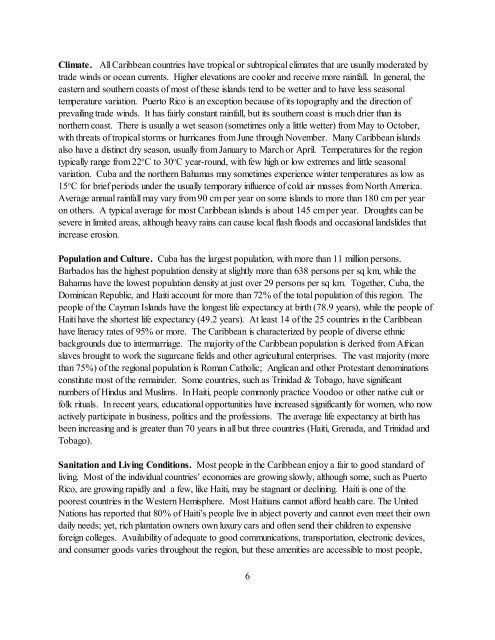Caribbean - Armed Forces Pest Management Board
Caribbean - Armed Forces Pest Management Board
Caribbean - Armed Forces Pest Management Board
You also want an ePaper? Increase the reach of your titles
YUMPU automatically turns print PDFs into web optimized ePapers that Google loves.
Climate. All <strong>Caribbean</strong> countries have tropical or subtropical climates that are usually moderated by<br />
trade winds or ocean currents. Higher elevations are cooler and receive more rainfall. In general, the<br />
eastern and southern coasts of most of these islands tend to be wetter and to have less seasonal<br />
temperature variation. Puerto Rico is an exception because of its topography and the direction of<br />
prevailing trade winds. It has fairly constant rainfall, but its southern coast is much drier than its<br />
northern coast. There is usually a wet season (sometimes only a little wetter) from May to October,<br />
with threats of tropical storms or hurricanes from June through November. Many <strong>Caribbean</strong> islands<br />
also have a distinct dry season, usually from January to March or April. Temperatures for the region<br />
typically range from 22 o C to 30 o C year-round, with few high or low extremes and little seasonal<br />
variation. Cuba and the northern Bahamas may sometimes experience winter temperatures as low as<br />
15 o C for brief periods under the usually temporary influence of cold air masses from North America.<br />
Average annual rainfall may vary from 90 cm per year on some islands to more than 180 cm per year<br />
on others. A typical average for most <strong>Caribbean</strong> islands is about 145 cm per year. Droughts can be<br />
severe in limited areas, although heavy rains can cause local flash floods and occasional landslides that<br />
increase erosion.<br />
Population and Culture. Cuba has the largest population, with more than 11 million persons.<br />
Barbados has the highest population density at slightly more than 638 persons per sq km, while the<br />
Bahamas have the lowest population density at just over 29 persons per sq km. Together, Cuba, the<br />
Dominican Republic, and Haiti account for more than 72% of the total population of this region. The<br />
people of the Cayman Islands have the longest life expectancy at birth (78.9 years), while the people of<br />
Haiti have the shortest life expectancy (49.2 years). At least 14 of the 25 countries in the <strong>Caribbean</strong><br />
have literacy rates of 95% or more. The <strong>Caribbean</strong> is characterized by people of diverse ethnic<br />
backgrounds due to intermarriage. The majority of the <strong>Caribbean</strong> population is derived from African<br />
slaves brought to work the sugarcane fields and other agricultural enterprises. The vast majority (more<br />
than 75%) of the regional population is Roman Catholic; Anglican and other Protestant denominations<br />
constitute most of the remainder. Some countries, such as Trinidad & Tobago, have significant<br />
numbers of Hindus and Muslims. In Haiti, people commonly practice Voodoo or other native cult or<br />
folk rituals. In recent years, educational opportunities have increased significantly for women, who now<br />
actively participate in business, politics and the professions. The average life expectancy at birth has<br />
been increasing and is greater than 70 years in all but three countries (Haiti, Grenada, and Trinidad and<br />
Tobago).<br />
Sanitation and Living Conditions. Most people in the <strong>Caribbean</strong> enjoy a fair to good standard of<br />
living. Most of the individual countries’ economies are growing slowly, although some, such as Puerto<br />
Rico, are growing rapidly and a few, like Haiti, may be stagnant or declining. Haiti is one of the<br />
poorest countries in the Western Hemisphere. Most Haitians cannot afford health care. The United<br />
Nations has reported that 80% of Haiti’s people live in abject poverty and cannot even meet their own<br />
daily needs; yet, rich plantation owners own luxury cars and often send their children to expensive<br />
foreign colleges. Availability of adequate to good communications, transportation, electronic devices,<br />
and consumer goods varies throughout the region, but these amenities are accessible to most people,<br />
6

















